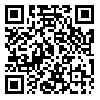Volume 18, Issue 2 (4-2018)
Modares Mechanical Engineering 2018, 18(2): 179-188 |
Back to browse issues page
Download citation:
BibTeX | RIS | EndNote | Medlars | ProCite | Reference Manager | RefWorks
Send citation to:



BibTeX | RIS | EndNote | Medlars | ProCite | Reference Manager | RefWorks
Send citation to:
Sahebi Z, Yarahmadi M. Hybrid adaptive intelligent controller design using quantum wavelet neural networks for trajectory tracking control in finite dimensional closed quantum systems. Modares Mechanical Engineering 2018; 18 (2) :179-188
URL: http://mme.modares.ac.ir/article-15-11156-en.html
URL: http://mme.modares.ac.ir/article-15-11156-en.html
1- Department of Mathematics and Computer Science, Faculty of Science, Lorestan University, Khorramabad, Iran
Abstract: (4150 Views)
In this paper, a new hybrid adaptive intelligent controller is introduced to track a dynamic trajectory in finite dimensional closed quantum systems. The problem of inherent singularities in control signals of trajectory tracking in quantum systems leads to a sharp increase in control signal amplitude. As a result, the amplitude of the large signal increases the control cost and control system instability. Consequently, the large control signal amplitude increases the control cost and leads to instability in control system. Firstly, according to the Lyapunov stability theory, an adaptive controller is designed to track the dynamic path. Then, to overcome the singularity drawback, a quantum intelligent controller is designed based on a quantum adaptive wavelet neural network with batch back propagation learning and combined with adaptive controller by a singularity observer. The proposed hybrid adaptive intelligent controller by combining the adaptive and intelligent control signals adjusts the quantum state so that the desired dynamic trajectory is traced effectively and simultaneously eliminates the effects of singularities and reduces the control amplitude. The performance of the hybrid adaptive intelligent controller is checked for step response tracking in a population transfer of a four-level closed quantum system. The simulation results show that the introduced controller reduces the tracking error and significantly decreases the number of singular points. Also, the control cost is reduced by effective adjustment of the control signal’s amplitude.
Article Type: Research Article |
Subject:
Control
Received: 2017/10/30 | Accepted: 2018/01/9 | Published: 2018/01/25
Received: 2017/10/30 | Accepted: 2018/01/9 | Published: 2018/01/25
| Rights and permissions | |
 |
This work is licensed under a Creative Commons Attribution-NonCommercial 4.0 International License. |







